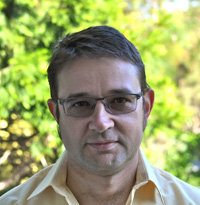Alexander Sher, assistant professor of physics, has received a grant totaling $2.5 million over five years from the National Eye Institute, part of the National Institutes of Health (NIH). The grant supports Sher's research on how the retina heals itself after laser surgery.
Sher uses custom-designed arrays of microscopic electrodes to study the activity of retinal neurons. He contributed to recent research showing that light-sensitive photoreceptors can migrate into retinal lesions caused by selective laser photocoagulation and reconnect with retinal neurons to fill in blind spots. Last year, he received funding as a Pew Scholar in the Biomedical Sciences for a project to further explore how the retina responds to this laser treatment. The new NIH grant provides major funding for Sher's ongoing investigation of the potential to restore retinal function after injury or disease.
"Our earlier findings demonstrated that the retina has the potential for constructive plasticity that was never observed or even suspected before," Sher said. "Our goal is to establish the mechanism and the limits of this new and exciting phenomenon."
Laser photocoagulation is widely used to treat retinal diseases, but side effects of the current standard method include retinal scarring and blind spots. A new approach, using shorter pulses of laser light, destroys photoreceptor cells but leaves underlying retinal neurons intact. Sher has documented the migration of photoreceptor cells into the lesion, where they establish new connections with inner-retinal neurons.
"The newly discovered phenomenon of photoreceptor migration and rewiring may enable restoration of visual function in retinal lesions," Sher said.
The newly funded research will contribute to the development of selective photocoagulation as a novel treatment for retinal diseases without the side effects of the current standard of care. The research will also provide insights into how the intricate connectivity of photoreceptors and other neurons develops in the adult retina, and how transplanted stem cells can integrate into the retina.
The microarray system Sher uses is one he helped develop as a postdoctoral researcher working with physicist Alan Litke at the Santa Cruz Institute for Particle Physics (SCIPP). The laser photocoagulation procedures will be conducted in collaboration with Daniel Palanker of Stanford University.



